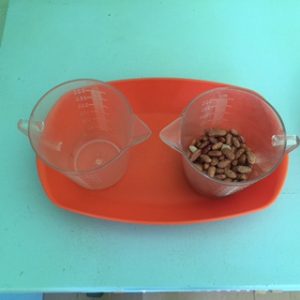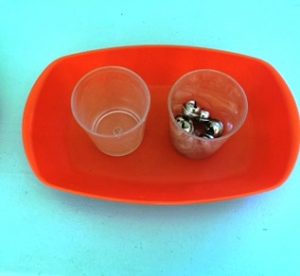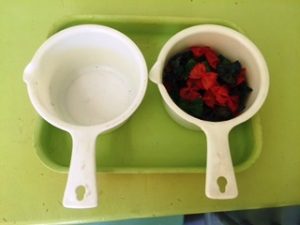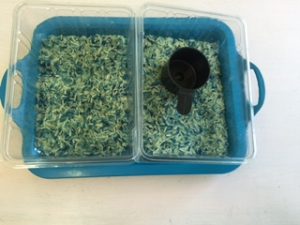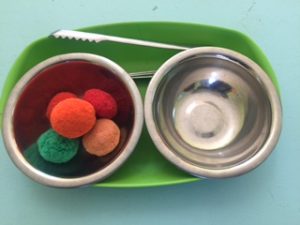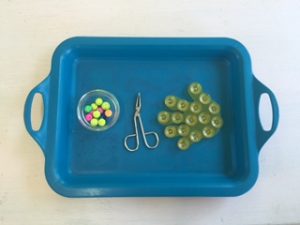Practical life activities are one of the most essential you will find in any Montessori classroom because they introduce the child to the basic functions that they will need in everyday life.
So, how can these activities help my child?
- Coordination
- Practising control of movements
- Fosters independence
- Concentration
- Working from left to right
How can parents get started at home?
All children are at different levels of skills and have different interest, which is important to remember. When you are initially choosing work and starting this system, think about your child and what they like, what they are interested in and what they can be independent at. You can start this process using all things that you already have. Creating the space and teaching the process is the first step. The goal is to create independence and predictability.
Setting up a work space
- Find an area that you can dedicate to your child and the materials. You will need space for a shelf or low counter of some sort as well as a place for your child to sit and work, either a child sized table or mat on the floor.
- Choose a shelf/cabinet system. This needs to be a shelf that is low enough that your child can reach the items. Create a space for your child to sit and work. If you have a child size table that works for your child great, otherwise find a small rug or mat to define their work space and keep their materials confined and manageable.
Getting Started
- Create some very basic activities to get your child started. I would recommend choosing activities that will keep your child’s interest, but are not too challenging to start with.
- Only set out a couple of activities at a time until your child demonstrates an understanding in the process and use of the materials.
- When you place the work on the shelf, always put them in the same location so that your child can find them, this increases independence and predictability.
- Introduce the process and the works you have chosen.
A few examples of what you will need: ( You can find these items easily in your home)
- Small plastic trays with handles
- Small and medium size bowls
- Small jugs
- Rice, beans, pasta, granules etc.
- Tweezer/tongs
- A small whisk
- Small bottles/boxes
- Small spoons
- Different size buttons, coloured buttons,pom poms etc
- Dropper bottles
- Shoe laces and threading beads
- A muffin tray
- A small plastic funnel
- Small cloths
- A small tea pot with a tea cup
- A small sponge.
- Perfume bottles and small boxes.
- Jars with different lids.
- A syringe (without the needle)
Process
Once you have created and set up a space and chosen a couple activities to start with, show your child the space and introduce one activity modeling the entire process start to finish.
- Invite your child to work with you with an activity.
- Carry the work to the work space.
- Set the tray down on the left side of the child.
- Name the activity.
- Perform the activity to your child from start to finish.
- Exaggerate your movements.
- Demonstrate the activity slowly and do not talk whilst presenting the activity as your child needs to focus on your actions and not what you are saying.
- After you have completed the activity, invite your child to work with the activity and do not interrupt your child otherwise it prevents your child from concentrating.
- Once your child has completed the activity, show your child where to place his activity back on the shelf.
- Carry the work back to the shelf.
Ideas for practical life activities:
Place the activities on individual small trays with handles.
- Pegging and unpegging pegs around a small bowl.
- Spooning coloured rice/beans from one small bowl to another with a small spoon
- Tweezing pop corn kernels from one bowl to another
- Pouring rice/ beans etc from one jug to another
- Pouring water from one jug to another
- Pouring water from a jug into 2 cups
- Tonging pom poms from one bowl to another
- Screwing and unscrewing nuts and bolts
- Whisking dishwashing liquid squeezed in a bowl of water
- Syringing water from one bowl to another
- Squeezing water droplets from a dropper bottle onto a soap pad.
- Threading beads
- Folding small cloths with lines into a half, quarter etc.
- Plaiting wool
- Folding clothes
- Pouring water through a funnel
- Sorting small objects into a muffin tray
- Sponging water from one bowl to another
- Opening and closing boxes and bottles
- Syringing water from one bowl to another
- Sorting different coloured buttons into bowls
Let your child have fun!
The Importance of Practical Life Activities in the Montessori Preschool Classroom and in your home
If teaching is to be effective with young children, it must assist them to advance on the way to independence. It must initiate them into those kinds of activities, which they can perform themselves.
“We must help them to learn how to walk without assistance, to run, to go up and down the stairs, to pick up fallen objects, to dress and undress, to wash themselves, to express their needs, and to attempt to satisfy their desires through their own efforts. All this is part of an education for independence.”
Maria Montessori, The Discovery of the Child
Psychologists have argued that childhood is a natural phase of growing up. Indeed, Maria Montessori believed that children are innately preparing to be adults. She further stated that parents and teachers needed to provide a strong foundation of skills and work habits that would eventually allow them to be responsible for the caring of their own families, homes, community and environment. These skills, when taught early in life, allow children to believe in themselves as well as developing the self-discipline needed for success throughout their lives.
The Importance of Practical Life Activities in the Montessori Preschool Classroom.
Montessori stated that at each plane of development there is a sensitive period for different skills and activities. It is critical that proper stimulation be provided as nature intended. Practical Life activities, provides an introduction and smooth transition to the Montessori school by linking the activities that the child is familiar with at home to the school environment.
Children appreciate spending their time helping adults with their activities. When allowed to do so, the child learns that his contributions are of value, thus boosting his self-esteem and independence. He should be encouraged to use child-size replicas of adult tools.
In short, the direct aim of Montessori Practical Life activities is to help develop social skills and independence. Indirectly, Practical Life activities develop fine motor skills, as well as strengthening intellect, concentration, and personal will.
The importance of beauty in the Montessori classroom can be keenly observed in the Practical Life area of the classroom. Practical Life activities have a unique purpose which, when carried out properly, are very calming.

